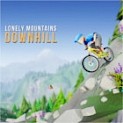Review: Lonely Mountains: Downhill

Posted 03 Jun 2020 at 23:25 by Lee Davies
The sound of the wind tearing between two rocky overhangs, the chirping of playful sparrows, the echoing rattle of a woodpecker, the roar of a powerful waterfall plunging past an old wooden bridge, all serve as a succinct counterpoint to the clacking rotation of a bike’s gears and the loosening of dirt under a rear wheel frantically asking for more grip than can be given. Lonely Mountains: Downhill eases you into its stylistic racing in a gentle afternoon outing and slowly asks more of you with each trail attempt.
An isometric mountain bike checkpoint racer can’t describe what is fully offered in this game. At first glance, the content may seem sparse to some. A total of four mountains, each with four trails to traverse, all locked behind challenges that slowly push you to the game’s completion. Sixteen tracks in total, but each offering a variety of vistas and sounds distinct from all others. The mountains in themselves vary immensely in terms of architecture and visuals: Graterhorn is a pine covered, windy, rocky mountain top; Redmoor Peaks, full of autumnal oaks, reds, yellows and oranges, streams, huge waterfalls, and rapids; Sierra Rivera, an arid desert landscape reminiscent of the Grand Canyon, complete with cacti and the occasional sandstorm; and Mount Riley, a treacherously steep mountain top that leads to lower lying, bog infested marshes.
Each of the four trails winds its path down its single mountain in a clever and well designed way that always ends with your rider at the same base camp. The amount of short cuts available, to get your rider to that goal, is staggering, but somehow the level designers have engineered it so you never miss a single checkpoint.
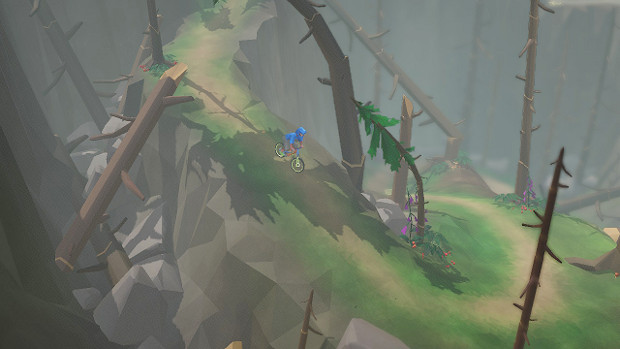 Check out the polygonal edge to the landscape, coupled with some carefully crafted courses.
Check out the polygonal edge to the landscape, coupled with some carefully crafted courses.
The visuals in the game are quite literally beautiful. A slight polygonal edge to everything is framed in a cartoon cell shaded tint, and accentuated by the perfectly implemented blur effect. At first, it feels a shame that the background is blurred out in favour of the more immediate central features of the rider and his/her local surroundings. After playing for just a few minutes, and realising that success on every trail requires a focus and awareness of the exact location and direction of your rider at all times, then the blurred effect of the background makes more sense. It’s so easy to be distracted by specific locations, for example, the beauty of a waterfall as you leap across the ravine from either side of it. The pinpoint sharp camera focus upon the rider lets you locate your character with a rapidity that is necessary to give you the best chance of success.
The camera is set up in a way that follows your rider down the trail and slowly zooms out when required, but never rotates around your rider. For the vast majority of the trails, the designers have positioned the camera in such a way that allows you to visualise enough of the coming track, and subsequent cycling accidents, therefore, are your error in every sense of the word. Only on a handful of occasions was the rider obscured by a rock face or tunnel, and these are fleeting moments. Some of them, like the overhanging trees, are for visual effect and added depth. The visuals whilst playing in handheld are not fully comparable to docked, as there is an evident jagginess to all those crisper lines seen on a TV screen.
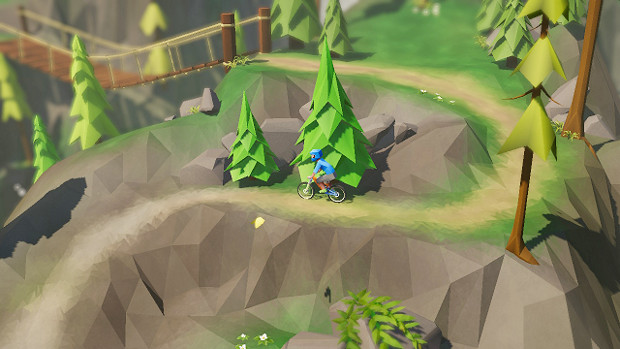 Those trees look sharp enough to take out your tires on the way past, keep a look out ahead...
Those trees look sharp enough to take out your tires on the way past, keep a look out ahead...
The sumptuous visuals are more than complemented by Lonely Mountains: Downhill’s sound design. The lack of a soundtrack is abundantly clear from the very first moment of play. Gone are the rock inflected melodies of other racing games, to be replaced solely by the sounds of nature. The sound design grounds you into the reality of the locations, rustling leaves, trickling streams, animals chirping and cawing, waterfalls, and most prominently, the sounds of the mountain bike traversing through these landscapes. The free wheeling clack of the gears, the variety of sounds that the tyres make upon different terrain, and of course, the screaming of a rider plunging off a 100 foot cliff edge. It’s all just so atmospheric, and even more so when playing in handheld with a nice set of headphones.
All these gorgeous sounds and visuals would mean very little if Lonely Mountains: Downhill ran badly at a fundamental level, or had poorly implemented controls. And, in this regard, it performs admirably. A solid frame rate throughout was only marred by two instances, during my 5 hour playthrough, of frame glitching and losing a moment of the action during a checkpoint transfer. For the majority of the game, you’ll be seeing a fluid frame rate that keeps up with the action at all times. On the control of the rider, there is an option to choose between two control methods, a secondary old-school style left and right turning system, or the default, and preferred, pointer style controls, where the rider will turn on screen to the corresponding direction to which you lean the analogue stick.
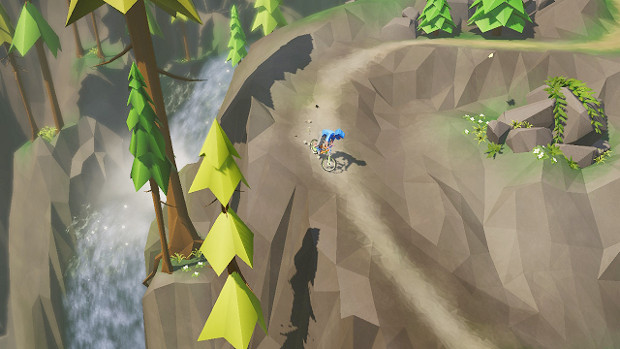 ...as you really don't know what's around the corner, you can almost feel the ferocity of the waterfall.
...as you really don't know what's around the corner, you can almost feel the ferocity of the waterfall.
Just as in real life, a mountain bike has a turning circle, and by rotating the analogue stick through a U-shaped movement makes turning corners as natural as riding a bike. This feels perfectly implemented when using Nintendo’s Pro Controller, but feels ever so slightly less accurate when playing handheld using the JoyCons, which is a problem of the hardware, not the game itself. Couple this precision control with the ZL brake, ZR pedal (accelerate), and A to stamina sprint, and the feel of sliding around corners by perfectly weighting the brake, angle of slide, and sprint out to a straight, is immensely satisfying when performed correctly. When the opposite happens, you’ll know who to blame, yourself. And when you do eventually have a nasty incident of bone crunching proportions, pressing the A button rejoins the action instantly to the last checkpoint reached. The checkpoints are always quite far away, but always intriguingly close enough for one more try to get to the next elusive one. Loading a level from the beginning is what takes the most time, but it’s not a huge wait. Normally, 15 seconds from the main menu to the start of an attempt at a trail is par for the course.
Upon starting the game, everything bar the one opening trail is locked to you. There are four levels of difficulty to make your way through for each and every trail. You’ll always have to completely finish all the challenges upon the previous level of difficulty to open the next one. Explorer is the starting level, it has no time pressure, and all you have to do is cross the finish line to complete the challenge and unlock the next difficulty on that trail, Beginner. Explorer is best taken slowly to learn what new threats you’re likely to encounter when playing at the higher settings, and is great for finding the hidden resting spots on each trail, one for each.
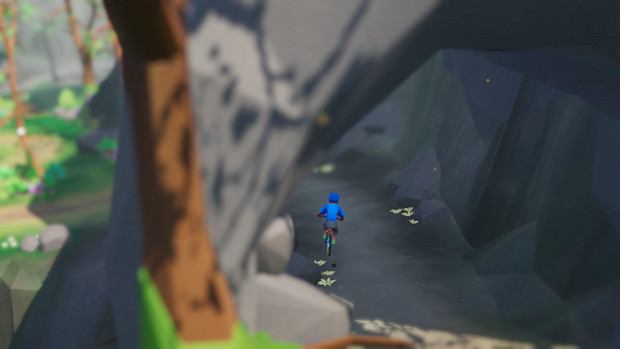 A very nice depth of field effect, which highlights your rider while softening the scene in places.
A very nice depth of field effect, which highlights your rider while softening the scene in places.
It’s at the Beginner difficulty that you can work towards unlocking new trails, new bikes, new mountains, and the Expert difficulty level. Each trail at Beginner has up to two challenges that invariably task you with individual time based or crash based events. To unlock everything at this difficulty level took me about 4 hours in total. It’s in Expert that the real challenge begins. Tasking you to go faster with fewer accidents and on a specific bike often leads to a little frustration, but determination will win the day. The last difficulty is Free Rider which adds the not so simple challenge of completing an entire trail without taking a single fall. Doing this on certain trails will unlock the hidden and soul destroying Night Mode. A pitch black run, with its own set of challenges, lit only by your bike’s front headlight.
So, the initial concern of a lack of courses is made redundant by the thoughtful use of challenges that push you to your very limit on each trail. Add in: six bikes to unlock, each with their pros and cons: customisation unlocks, for your bike and rider; online global leaderboards, with exceptional filters that include friends, and break down individual trails and their checkpoint section times; achievements to unlock, from gaining bikes, to completing challenges, crashes (like hitting two trees in one crash), or hitting cacti 100 times; and, a plethora of stats, from your best runs, longest jumps, highest top speeds, and what bike you performed those with.
N-Europe Final Verdict
Being lonely isn’t such an issue when the surrounding vistas are varied, beautiful, and full of the ambient noises of nature taking you on your journey down through treacherous passes to the root of the mountain, whether that be in safety, or more often than not, a plummeting plunge off a cliff. Lonely Mountains: Downhill manages to brace the dichotomy of being a relaxing and beautiful Sunday afternoon bike ride with the challenge and frustration of difficult later challenges.
- Gameplay5
- Playability5
- Visuals4
- Audio5
- Lifespan3
Final Score
8
Pros
Beautiful visual style
Rich ambient nature sounds
Perfect controls
Challenging and relaxing in equal measure
Cons
Camera infrequently obscures a necessary path
Very infrequent frame freezes
Preferable to play with a Pro Controller


